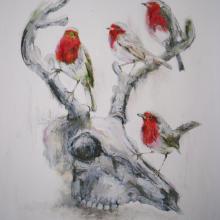
'Carrion' is a two-person exhibition fascinated by physical and psychological vulnerability. Coincidentally, both Sarah Green and Gregor Laird focus that sense of vulnerability on the human eye, and the sense of exterior threat on the uncanny gaze and ruthless appetite of birds.
Laird – who incidentally is part of the team responsible for the window displays at Harvey Nichols on St Andrew Square – is disturbingly adept at twisting the knife. 'Bleak Mid Winter' (right) evokes in its title a beautiful carol, but one is confronted by death in the form of a stag's skull. One is then cheered by the sight of jolly robins perched on the antlers, before wondering whether in fact these are robins (which do not flock) or some other species reddened with blood after stripping the skull of flesh.
It will come as no surprise to learn that Laird is interested in vultures, but all birds he imbues with sinister potential. The eyes in the plumage of a white peacock have mutated into skulls, some unseen sparrow has murdered Cock Robin, perhaps the one which is itself murdered by a hawk in the adjacently hung painting. In yet another, gruesome study – Hands that Feed – a bird perched on a human hand pulls at something one at first takes to be a worm. Closer inspection reveals a tendon being dragged from the wrist.
In another thread of paintings, Laird's visceral scorn is reserved for Michael Jackson, as in Anatomy of a False Icon. (The inflated demi-god is revealed to have been only flesh and blood.) Perhaps the most unsettling of these is his Neverland, showing a clearly terrified Bubbles (Jackson's chimpanzee, pet and prop) in the process of smearing out of existence.
If Laird's work sounds gruesome, that is because it often is, but it is not always uncompromising or without mordant humour, particularly in his interplay between titles and images, expectations and realities.
Less playful and more keenly felt, perhaps, are the horrors expressed in Sarah Green's works. Recurring themes are the face as mask, and the possibility of one's most private and intimate self being accessed or extracted via the eyes.
In some pictures she examines the rheumy, watery eyes of old age and how they reveal a stage towards the end of life 'between here and there'. The cumulative re-examination of eyes in There is a Lesson to be Learned Here Somewhere is strangely fascinating and discomfiting. In Behind a Painted Smile – applicable equally to an artist's subject and the everyday wearing of make-up – we see the terrifying ferocity of a cat at bay. Suspicion of emotional commitment is suggested by the image of a jackdaw, a key in its beak, and a collection of 'inappropriate' glittering eyeball trophies.
Green's style elsewhere has a film-noir slant. The women in Perfect Receptacle and Gape seem to be in the midst or on the cusp of suffering sexual violence, even murder. These, to my mind, are among the most technically accomplished in the exhibition.
Neither Green nor Laird's are comfortable images to consider, but they make you think, are often moving. They are certainly well worth a visit. AM
'Carrion' will carry on at Axolotl Gallery (35 Dundas Street) until 1 August.